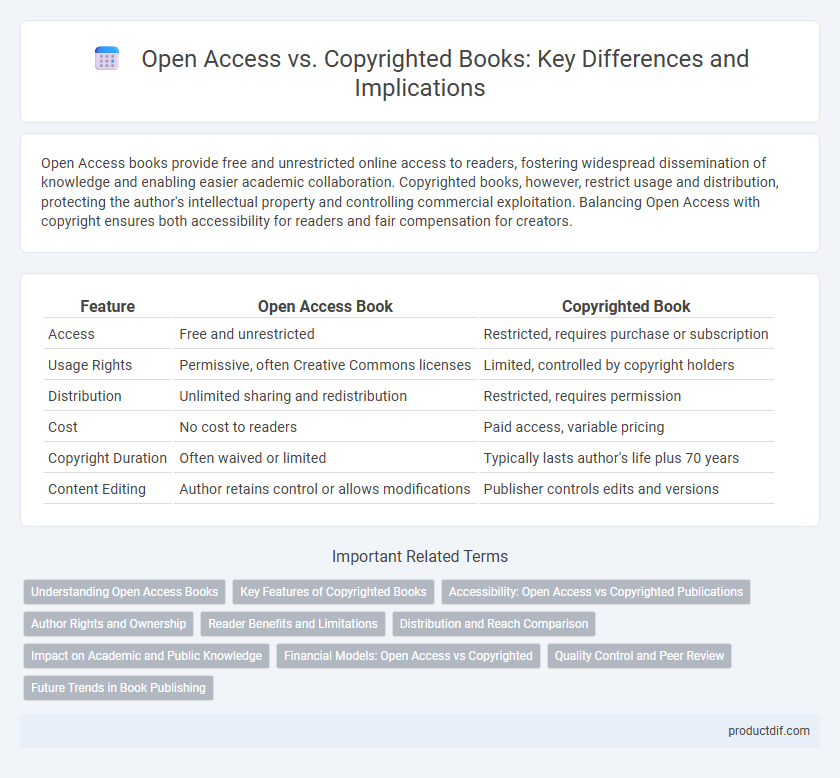Open Access books provide free and unrestricted online access to readers, fostering widespread dissemination of knowledge and enabling easier academic collaboration. Copyrighted books, however, restrict usage and distribution, protecting the author's intellectual property and controlling commercial exploitation. Balancing Open Access with copyright ensures both accessibility for readers and fair compensation for creators.
Table of Comparison
| Feature | Open Access Book | Copyrighted Book |
|---|---|---|
| Access | Free and unrestricted | Restricted, requires purchase or subscription |
| Usage Rights | Permissive, often Creative Commons licenses | Limited, controlled by copyright holders |
| Distribution | Unlimited sharing and redistribution | Restricted, requires permission |
| Cost | No cost to readers | Paid access, variable pricing |
| Copyright Duration | Often waived or limited | Typically lasts author's life plus 70 years |
| Content Editing | Author retains control or allows modifications | Publisher controls edits and versions |
Understanding Open Access Books
Open Access books provide unrestricted, free online access to scholarly content, enhancing visibility and wider dissemination of knowledge compared to copyrighted books, which limit access through purchase or licensing. These freely accessible books often operate under Creative Commons licenses that allow users to share and reuse content legally, fostering academic collaboration and innovation. Understanding the balance between Open Access and traditional copyright models is essential for authors, publishers, and readers navigating the evolving landscape of digital publishing.
Key Features of Copyrighted Books
Copyrighted books grant exclusive rights to authors and publishers, ensuring control over reproduction, distribution, and derivative works. These protections incentivize creativity by offering legal mechanisms for income and recognition. Copyright typically lasts for the author's lifetime plus 70 years, restricting unauthorized access and use during this period.
Accessibility: Open Access vs Copyrighted Publications
Open Access publications provide unrestricted access to scholarly content, enabling wider dissemination and increased visibility for authors and researchers globally. Copyrighted publications restrict usage and require purchase or subscriptions, limiting accessibility primarily to institutions or individuals who can afford access. Open Access enhances knowledge sharing by removing financial and legal barriers, while copyrighted works maintain control over distribution and monetization.
Author Rights and Ownership
Open Access books grant authors greater control over distribution and reuse of their work, enabling wider dissemination while retaining original authorship rights. Copyrighted books typically transfer exclusive rights to publishers, limiting authors' ability to share or modify their content without permission. Authors in Open Access models often benefit from increased visibility and citation potential, enhancing their academic impact and career advancement.
Reader Benefits and Limitations
Open Access books provide unrestricted, free access to readers, enabling immediate availability and wide distribution, which enhances knowledge dissemination and academic collaboration. Copyrighted books, while often offering high-quality, professionally curated content, require purchase or subscription, limiting access based on financial constraints and geographical restrictions. Readers benefit from Open Access through greater inclusivity and continuous updates, whereas copyrighted materials ensure content protection and potential author royalties.
Distribution and Reach Comparison
Open Access books enable unrestricted distribution and global reach, allowing anyone with internet access to freely download, share, and distribute content without legal barriers. Copyrighted books limit distribution to authorized sellers and platforms, often restricting access to paying customers and geographic regions, which can significantly reduce potential readership. This difference in accessibility profoundly impacts the dissemination of knowledge, with Open Access fostering broader academic and public engagement.
Impact on Academic and Public Knowledge
Open Access books significantly enhance the dissemination of academic research by allowing unrestricted online access, increasing visibility, and fostering collaboration among scholars worldwide. Copyrighted books, while protecting authors' intellectual property and potential revenue, often limit accessibility, creating barriers to knowledge for students, researchers, and the general public. The widespread availability of Open Access publications accelerates innovation and democratizes education by providing equal opportunities for learning and advancement across diverse communities.
Financial Models: Open Access vs Copyrighted
Open Access books leverage alternative financial models such as institutional funding, author fees, and grants to ensure free public availability, reducing barriers for readers and enhancing global knowledge dissemination. Copyrighted books primarily rely on traditional revenue streams including sales, royalties, and licensing fees, which can limit accessibility due to higher costs. The contrasting financial strategies impact the scalability, reach, and sustainability of scholarly publishing in different markets.
Quality Control and Peer Review
Open Access books benefit from rigorous quality control and peer review processes that ensure academic credibility while maximizing accessibility. Copyrighted books often undergo thorough editorial and peer review stages that maintain high standards but limit widespread distribution due to licensing restrictions. Balancing quality control with accessibility, Open Access models promote scholarly communication without compromising the integrity confirmed by traditional peer review.
Future Trends in Book Publishing
Future trends in book publishing indicate a significant shift towards open access models, driven by increasing demand for free and unrestricted access to scholarly works. Advances in digital distribution and licensing technologies are enabling more authors and publishers to adopt open access, reducing reliance on traditional copyright restrictions. Despite this, copyright protections will continue to evolve to balance author rights with broader dissemination, fostering innovative hybrid models that combine free access with monetization strategies.
Open Access vs Copyrighted Infographic

 productdif.com
productdif.com